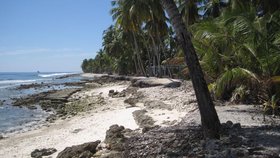Concrete wall at the dream beach
Primary losers of climate change, the Small Island States such as Tonga or Kiribati, but also tourist magnets like the Bahamas or the Maldives are threatened to sink into the sea when the ice sheets of Greenland and in the Antarctic melt.
But what can be done to protect people and dream beaches from the consequences of climate change?
Geographer and climate researcher Prof. Beate Ratter (Center for Earth System Research and Sustainability, CEN/ University of Hamburg), PI of the DICES project of the SPP SeaLevel program, spoke at the Science Year 2016*2017- Seas and Oceans (Wisseschaftjahr) about the counteractive impacts of measures taken against coastal erosion in small islands.
Although protective walls and dams provide a sense of security, they often create new problems. Where the sea encounters an obstacle with high energy, strong currents form, causing additional sand to be whirled up and carried away. As a result, the erosion of the coasts even increases.
In contrast, protecting the coral reefs, for instance, that surround many islands can act as a natural breakwater against rushing waves, provided they are biologically intact and grow well enough to keep up with sea level rise. Likewise, mangrove forests, which contribute to the construction of sandy beaches as natural sediment traps, are better suited than rigid bastions, but such beaches are completely unattractive to tourists.
However, looking for solutions is not just about necessary knowledge, but also about how interests are negotiated, explains Prof. B. Ratter who has been travelling to the concerned regions for years and has been discussing with residents, governments, coastal engineers, hoteliers and contractors, in order to examine such competing utility interests and ask for the potential for alternative conservation measures. It turns out that from political and economic interests always something goes wrong.
As an example, Prof. Ratter describes the case of the island Fuvahmulah in the south of the Maldives, where the population was waiting for years for a new, safer harbor. When this was finally built in 2003, it was located in the wrong position due to political reasons. Normally, as the monsoon changes seasonally, the sand is distributed evenly in one direction or the other around the island. The new harbor wall blocks this process. The sand collects in the blind spot in front of the harbor or is carried out to the sea, where it sinks into the deep and the island is permanently lost. On the east coast of the island, the sand is now completely cleared away - there, the bare rock now appears open. In order to protect the island in the future, the next construction project is already being considered: a huge stone bed. This stone dam - a so-called revetment - will result in a further chain reaction and further promote erosion on the island.
Coastal protection costs and tourism is the most important source of income for many islands, but at the same time, not every measure looks attractive for holiday guests. Of course it is important to know how the climate changes and what that means for small islands. What is crucial, however, is the willingness - both in politics and in the population - to deal with the consequences of climate change as a common task.
The original article, published at Science Year 2016*2017- Seas and Oceans can be seen here.

